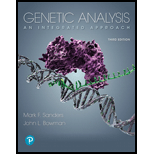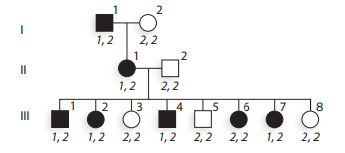
Concept explainers
Neurofibromatosis

a. Determine the alleles for the
b. Based on the phase of alleles on chromosomes in generation
c. What is the estimated recombination frequency between the
Trending nowThis is a popular solution!
Learn your wayIncludes step-by-step video

Chapter 5 Solutions
Pearson eText Genetic Analysis: An Integrated Approach -- Instant Access (Pearson+)
Additional Science Textbook Solutions
Campbell Biology (11th Edition)
Biological Science
Concepts of Genetics (12th Edition)
Biology: Life on Earth (11th Edition)
Becker's World of the Cell (9th Edition)
Anatomy & Physiology (6th Edition)
- Consider the following two nonhomologous wildtype chromosomes, where letters or numbers represent genes, the "-" represents the centromere of each chromosome, and chromosomes are shown on separate lines. ABCDE-FGHIJK 123-45678 Identify the type of rearrangement shown in each of the following (A-C) and then identify whether it is balanced or unbalanced. Assume that the individual is diploid and heterozygous for the rearrangement. A. ABCDE-FGHIJKGH 123-45678 Rearrangement: [Select] • Balanced or Unbalanced: [Select] B. ABCDGF-EHIJK 123-45678 Rearrangement: [Select] Balanced or Unbalanced: [Select]arrow_forwardFamilial Down syndrome is similar to primary Down syndrome in that it is caused by trisomy 21. However, in familial Down syndrome, all or part of the third copy of chromosome 21 has translocated onto another autosome, typically chromosome 14. In cases of familial Down syndrome, one of the parents of the affected child is often a carrier of a translocated chromosome. The translocation carrier parent does not have Down syndrome because he or she has a total of two copies of chromosome 21. Suppose that a woman is a translocation carrier of chromosome 21 on chromosome 14. She conceives six zygotes with a man who carries no aneuploidies. Match the description of the chromosomes inherited by each zygote with the viability and phenotype of the zygote. ✓ Two normal copies of 14, two normal copies of 21 two normal copies of 21, one normal copy of 14 ✓one normal copy of 14, one 21 to 14 translocation, one normal copy of 21 ✓two normal copies of 14, one normal copy of 21, on 21 to 14…arrow_forwardA tomato geneticist attempts to assign five recessivemutations to specific chromosomes by using trisomics.She crosses each homozygous mutant (2n) with each ofthree trisomics, in which chromosomes 1, 7, and 10 takepart. From these crosses, the geneticist selects trisomicprogeny (which are less vigorous) and backcrosses themto the appropriate homozygous recessive. The diploidprogeny from these crosses are examined. Her results, inwhich the ratios are wild type:mutant, are as follows:Which of the mutations can the geneticist assign towhich chromosomes? (Explain your answer fully.)arrow_forward
- Neurofibromatosis 1 is considered an autosomal dominant disorder because the gene is located on the long arm of chromosome 17. It is caused by microdeletion at the long arm of chromosome 17 band 11 sub-band 2 involving the NF1 gene. Group of answer choices Statement 1 is correct. Statement 2 is incorrect Statement 1 is incorrect, statement 2 is correct Both statements are incorrect Both statements are correctarrow_forwardConcordance studies of twins for a neurodegenerative disorder show MZ= 46% and DZ= 15%. Further studies have shown a possible link to a gene on chromosome 9, however, there are some individuals in the study who have the allele but do not develop the disorder (group 1), and there are other individuals who do not have the allele yet develop the disorder (group 2). Amita's older sister and maternal uncle have this disorder. Currently, Amita & her 2 younger brothers do not show symptoms. Amita's paternal grandfather was rumored to have this disorder. 1. Draw the pedigree for Amita's family and determine the mode of inheritance if any. 2. Explain how the 2 groups in the study could be possible? 3. What would you tell Amita about the heritability of this disorder?arrow_forwardIn a cross in Drosophila, a female heterozygous for the autosomallylinked genes a, b, c, d, and e (abcde/ + + + + +) was testcrossedwith a male homozygous for all recessive alleles (abcde/abcde).Even though the distance between each of the loci was at least3 map units, only four phenotypes were recovered, yielding thefollowing data: Phenotype No. of Flies+ + + + + 440a b c d e 460+ + + + e 48a b c d + 52 Total = 1000 Why are many expected crossover phenotypes missing? Can anyof these loci be mapped from the data given here? If so, determinemap distances.arrow_forward
- A PORTION OF THE LINKAGE MAP OF CHROMOSOME 2 IN THE TOMATO IS ILLUSTRATED HERE. ci (compound influorescence) o (oblate) - 15 CM 20 CM p (peach) THE OBLATE PHENOTYPE IS A FLATTENED FRUIT, THE PEACH PHENOTYPE IS HAIRY FRUIT (LIKE A PEACH), AND COMPOUND INFLORESCENCE MEANS CLUSTERED FLOWERS. IGNORE THE PEACH LOCUS. AMONG 1000 GAMETES PRODUCED BY A PLANT OF GENOTYPE O CI /+ +, WHAT TYPES OF GAMETES WOULD BE EXPECTED, AND WHAT NUMBER WOULD BE EXPECTED OF EACH?arrow_forwardThe Klinefelter syndrome (disomy of the X chromosome in males) is a genetic disease caused by aneuploidy of the sex chromosomes in humans. Patients with the 47,XXY karyotype are male. Describe two genetic scenarios leading to patients with the Klinefelter syndrome.arrow_forwardBelow is a pedigree from one family (two parents and eight children). Four of the children (indicated by shaded shapes) are affected with a serious disease with an unknown genetic cause. a) For the disease, what pattern of inheritance (autosomal/sex-linked, recessive/dominant) is exhibited by this pedigree? b) Linkage analysis of the disease to a series of VNTR polymorphisms on human chromosome 5 is shown above. Is there evidence for linkage between the disorder and the VNTR? Briefly explain your answer.arrow_forward
- In humans, chromosome 16 sometimes has a heavily stained area near the centromere. This feature can be seen in a microscope, but otherwise has no effect on the phenotype of the person carrying it. When such a “blob" exists on a given copy of chromosome 16, it is a constant feature of that chromosome and is inherited. A couple conceived a child, but the fetus had multiple abnormalities and was miscarried. e.g., The fetus had three copies of chromosome 16, where 2 of the 3 copies of chromosome 16 had large blobs. Both of the mother's copies of chromosome 16 lacked blobs, but the father was heterozygous for blobs. The fetus was formed from a fertilization event that included a gamete produced by the in which nondisjunction occurred during the meiotic division. Select an answer and submit. For keyboard navigation, use the up/down arrow keys to select an answer. a mother; first. mother; second. father; first. C Your answer d father; second. E3 Fullso L e Insufficient information is provided…arrow_forwardIn a human genetic study, a family with five phenotypicallynormal children was investigated. Two children were “homozygous”for a Robertsonian translocation between chromosomes19 and 20 (they contained two identical copies of the fusedchromosome). They have only 44 chromosomes but a completegenetic complement. Three of the children were “heterozygous”for the translocation and contained 45 chromosomes,with one translocated chromosome plus a normal copy of bothchromosomes 19 and 20. Two other pregnancies resulted instillbirths. It was later discovered that the parents were firstcousins. Based on this information, determine the chromosomecompositions of the parents. What led to the stillbirths? Whywas the discovery that the parents were first cousins a key pieceof information in understanding the genetics of this family?arrow_forwardIn corn, the genes v (virescent seedlings), pr (red aleurone), and bm (brown midrib) are all on chromosome 5, but not necessarily in the order given. The cross: v+ pr bm/ v pr+ bm+ with v pr bm/ v pr bm produces 1000 progeny with the following phenotypes: v+ pr bm 226 v pr+ bm+ 229 v+ pr bm+ 153 v pr+ bm 185 v+ pr+ bm 59 v pr bm+ 71 v+ pr+ bm+ 36 v pr bm 41 What is the gene order, and the (b) genetic map of these three genes?arrow_forward
 Human Heredity: Principles and Issues (MindTap Co...BiologyISBN:9781305251052Author:Michael CummingsPublisher:Cengage Learning
Human Heredity: Principles and Issues (MindTap Co...BiologyISBN:9781305251052Author:Michael CummingsPublisher:Cengage Learning
